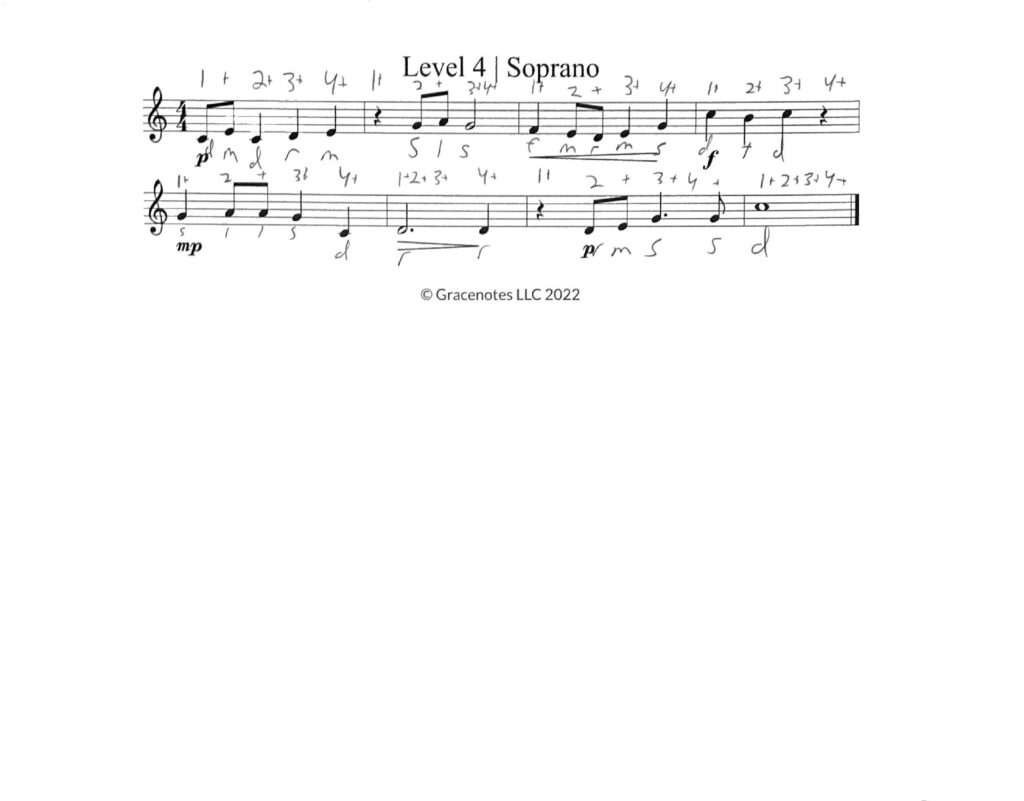Rhythm Comes Last
It is the 6th skill needed for being a successful sight singer and the most isolated of them all.
Sight-Singing is not a simple, specific skill
Great sight-singers can do these 6 things well:
- Match pitch
- Sing a scale in tune
- Sing alternating solfege patterns (skipping and step-wise)
- Master the aural training sheet
- Label notes on a staff at a fast pace (NOTE-LABELING)
- Label and perform rhythms on a staff at a steady pace (RHYTHM)
Why is Rhythm Last?
When it comes to learning how to sight sing, it is my belief that rhythm is least important. As mentioned in previous blog posts, the first 4 steps are built on top of one another. A singer must be able to match pitch before being able to sing a scale in tune. They must be able to sing a scale in tune before being able to effectively skip pitches. Finally, a singer cannot break apart the scale and sing random diatonic pitches before being able to sing simple skip pitches in a scale.
Step 5 is an isolated skill. The ability to decode pitches off of a staff with precision and speed has nothing to do with the development of the first 4 skills. Step 6, Rhythm labeling and performing is separate as well. What makes note labeling more important than rhythm labeling? Well, once a singer has developed Step 5, they will be able to quickly decode the notes of the staff and then access their ear using Steps 1-4. Without completing steps 1-4, step 5 has no musical value.
Rhythm, step 6, is completely separate. It can theoretically be practiced in complete isolation.
How does Rhythm development work for Sight-Singing Development?
Let me start by saying there are many people who innately understand rhythm yet do not understand it on paper. By paper, I mean they cannot accurately label rhythm AND cannot read the rhythm off a page. For sight singing purposes, the ability to read rhythm is a necessity.
In terms of rhythm development, I created a 5-step rubric, just as I have for the other 5 skills. In my sequence of steps, I always use the same 8-measure notation for both step 5 and step 6 . I personally see no reason to take rhythm out of context from regular sheet music by eliminating actual pitches.
The rhythm rubric addresses the basic concept of rhythm and expectations of someone who wants to be able to sight-sing. It focuses on 3/4, 4/4, and 6/8 time. For 3/4 and 4/4 time, the fastest rhythms they see is eighth notes and the most complex rhythm is a dotted quarter note. In 6/8 time they do not see notes faster than the 8th note. As mentioned, I believe that once a singer can accurately understand and perform fundamental rhythms, they have mastered the basics of this skill.
Rhythm Labeling/Performing Rubric Overview
How the levels work. The Rhythm Labeling/Performing Rubric is more elaborate and includes dozens of printable examples (provided by Sight Reading Factory), but this below give you an understanding of the conceptual framework.
- Level 1 – singer understands the time signature of 3/4 and 4/4 and can recognize the quarter note, half note, dotted half note, and whole note.
- Level 2 – singer begins to understand 8th notes. They understand how to label all of the beats in a measure, but don’t consistently place them in the right spots. (1+2+3+4+) or (1+2+3+)
- Level 3 – singer can label syncopation correctly with a dotted quarter note in 3/4 and 4/4 time. In 6/8 time, they understand how to label the beats (123456).
- Level 4 – singer can speak the rhythm of 3/4 and 4/4 with metronome marking of 60. In 6/8 time, they can speak rhythm with metronome marking of 120 bpm for the eighth note.
- Level 5 – singer can speak the rhythms in 3/4 and 4/4 without a metronome and can speak 6/8 time with a metronome of 40 bpm for the dotted quarter note playing
One additional note: if your singers are always practicing their note-labeling, (d, r ,m), they can speak the pitches with the rhythms as well. The singers should not sing the pitches along with the rhythm until they have mastered both steps 4 (Aural Training) and 5 (Note-Labeling).
Try SIGHT READING FACTORY and save 10% using code: choralclarity
Should we teach rhythm when the other skills haven’t been developed?
Yes. It is an isolated skill. Assuming a singer is struggling to match pitch, I would propose working on Steps 1, 5, and 6 concurrently.
Final words
Sight-singing truly involves the combining of multiple skills. Without this understanding, we may find many students who are not only unsuccessful, but immensely frustrated. Even with singers appear to be okay with sight-singing, I still highly recommend assessing each of these 6 skills independently. An average sight-singer in your choir may be struggling on Levels 4, 5, or 6 without you knowing it. It may even appear that they struggle in one category when they actually are struggling in another. For example, a singer might appear to struggle with rhythm, but they are actually struggling with decoding the notes; as they focus intently on reading the solfege, they don’t take the time to look at the rhythm. As a result, they get the notes correct and the rhythms wrong.
For a basic assessment in all 6 categories, I recommend using the Sight-Singing Developmental Rubric. If you need help gaining the skills in each category to help singers to improve, I recommend using the Sight-Singing Developmental Rubric BUNDLE.

